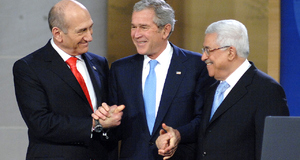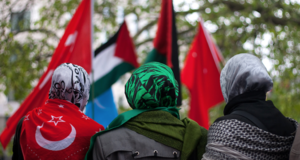The Obama PresidencyExamining the Image of the United States in the Arab World and the Relationship with Israel During the Obama AdministrationDomestic InfluencesConsidering the large degree of American support for Israel, it is worthwhile to examine two major domestic influences on U.S. policy towards Israel: AIPAC and congressional-Israeli relations. The two factors raise the stakes of not supporting Israel and its actions. The Role of AIPACFounded in 1963, the American-Israeli Public Affairs Committee (AIPAC) is the largest pro-Israel lobby in Washington whose stated mission is “strengthen, protect and promote the U.S.-Israel relationship in ways that enhance the security of Israel and the United States.”34 The lobby has historically enjoyed the support of both parties due to its emphasis on bipartisanship, and it has been a consistent and powerful source of influence on U.S. government policy towards Israel. One might even say its “hold on Congress has become institutionalized.”35 While AIPAC has maintained a healthy relationship with previous administrations, it has expressed opposition to numerous stances of the current administration. One of its biggest concerns coincides with Israel’s primary national security issue: Iran. AIPAC has long advocated for the complete stripping of Iranian nuclear capabilities, and has consistently been warning that such capabilities would pose an existential threat to Israel. Although it does not write bills, it has consistently supported legislation that imposes stricter sanctions on Iran for its noncompliance in matters of nuclear proliferation.Additionally, AIPAC has been very vocal about its opposition to the Obama administration’s stance on Israeli settlements. When President Obama called for a full settlements freeze in 2009, AIPAC rallied members of Congress to protest. There were also strong reactions after Obama endorsed the 1967 lines in his aforementioned 2011 speech on the Middle East and North Africa. The president clarified his position 3 days later at an AIPAC speech that the lines had to take into account demographic realities, which he declared the meaning of “mutually based swaps.”36 This speech is precisely Obama’s way of recognizing the role of AIPAC and domestic support for Israel. In the rather fiery address, he acknowledges that the two countries may disagree at time “as friends sometimes will,” but that the “bonds between the United States and Israel are unbreakable, and the commitments of United States to the security of Israel is ironclad.” On the issue of security, he noted a strong and secure Israel was in US interest “not just because of strategic interests and commonalities (…) comes from a deeper place: the values we share.”37 He touches on virtually every other aspect of the relationship between the U.S. and Israel, including the Iranian nuclear threat and the strong sanctions Obama administration had imposed on the regime, the considerable threat the Fatah and Hamas allegiance posed to peace, and that any party involved must recognize Israel’s right to exist, repeating that peace can never be imposed nor can Israel be singled out in the international arena. He declared the latter to be his “commitment, (his) pledge.”38 The pledge was tenuous at best with regards to Hamas and Fatah; three years later in 2014, his administrationworks with the Palestinian “national unity government,” defending it on the basis of technocrats and ministers not affiliated with Hamas. Israel dismisses such claims and staunchly opposes the move. Congressional-Israeli RelationsExamining AIPAC also warrants attention to congressional-Israeli relations. Although congressional support for Israel has long been a bipartisan staple of U.S. foreign policy, the relationship has not always been as rooted and robust as it is today. President Truman was the first world leader to recognize the newly born state of Israel in 1948, but the administration was hesitant about undermining relationships with Arab countries by doing so. Additionally, it was primarily concerned with the spread of communism; as the Soviets became more active in the region, so did the U.S. In the years since the Truman administration, congressional support of Israel has become a staple of U.S. policy. It also comes at little cost; the strength of organized interest groups such as AIPAC make it beneficial for most candidates to express support. A recent study also showed clear correlations between congressional involvement in foreign policy and actions regarding Israel.39 It is worth noting that foreign policy is an important function of Congress; the U.S. Constitution explicitly calls for legislative approval of foreign ambassadors and treaties as a means of “checking” the power of the executive branch. In the context of this analysis, it is worth noting that conventional divisions are beginning to affect U.S. party support for Israel. In short, a once uncontested issue is becoming more polarized and divided along traditional party lines within the U.S government. This transformation is illustrated in the tension between Republican House and President Obama in relationships with Netanyahu, as well as the recent lack of cooperation between parties in expressing their support for Israel, an occurrence termed “Congressional Dysergia.”40 The former was on full display back in May 2011, Netanyahu delivered a speech to a joint session of Congress just days after President Obama’s own Middle East speech. Netanyahu received an unprecedented 29 standing ovations (from members of both parties), indicating that U.S. congressional support for Israel is still firm. US Image: Then and NowThe election of Barack Obama raised hopes across the Arab region and even improved U.S. favorability ratings, but did his strategy towards the Middle East pay off? This analysis examines three comprehensive series of polls, conducted in incremental periods throughout Obama’s presidency. After the initial spike in U.S. ratings in the wake of Obama’s election, polling conducted across the Arab world in 2011 indicated a significant drop; ratings fell even lower than both the Bush-era lows and Iran’s favorable rating. A meager rating of 10% certainly speaks to an evaporated hope. Even more dismal were the two issues in which Obama received the lowest performance Obama's performance ratings: Palestine and engagement with the Muslim world; both were the clear recipients of most his energy concerning the Middle East. Additionally, the occupation of “Palestinian” territory and U.S. interference in the Arab world were cited as the greatest obstacles to peace and stability in the Middle East.41 It is also worthwhile mentioning that one of President Obama’s greatest achievements in the region thus far, the killing of Osama bin Laden, only worsened attitudes toward the U.S. Although Arab nations rendered Obama least effective in improving relations with the Arab and Muslim worlds, majorities gave him credit for “trying” to maintain good relations. Given the Obama’s overt outreach attempts, the issue still seems to boil down to the Arab-Israeli conflict. Indeed, despite U.S. attempts at brokering negotiations and consistent support for a two-state solution, along with the Obama administration’s blatant opposition to many Israeli policies- this administration has made it very clear that the US and Israel currently often have very different strategic interests- the polling data revealed very little confidence that the U.S. was “even-handed” in its approach to peace making. 42 Figure 1: U.S. favorability ratings, 2009-2011 (Source: Arab American Institute) Figure 2: Has Obama met expectations he set in 2009 Cairo Speech? (Source: Arab American Institute) Two years later, a 2013 Pew Research study conducted just between Israel and the Palestinian territories corroborated the results of the region back in 2011. Even in the wake of Obama’s 2013 trip to the West Bank and Jordan, Palestinian views of the president remained resoundingly negative; an astounding 82% said they had “little or no confidence” in him. Obama’s visit to Israel, on the other hand, seems to have paid off: his ratings jumped 12 points from 2011 to give him a 61% favorable rating in Israel.43 This is noteworthy considering his domestic approval rating of 49% at the time this polling was conducted.[44] The polling data also affirmed the Arab-Israeli conflict as the dominant determinant of ratings: Israel’s image was overwhelmingly negative in the region: 86% or more in Lebanon, Jordan, the Palestinian territories, Egypt, Tunisia and Turkey expressed unfavorable views of Israel. The U.S. was the only country where a majority of the population showed support.[45] In 2014, five years after President Obama’s visionary address at Cairo University, a comprehensive study conducted by the Arab American Institute showed a slight increase in both U.S. and President Obama’s ratings, despite prolonged negative attitudes toward several of its policies; most Arab countries, attitudes toward the United States are back to where they were in 2009. The polling notes, “Arabs judge the Obama Administration to have been most effective in “ending the U.S. presence in Iraq” and ‘working to end Iran’s nuclear program;’” as before, they rendered him least effective in “improving relations with the Arab/Muslim Worlds and “handling the Israeli-Palestinian conflict and the Arab Spring.” Additionally, majorities in every Arab country continued to express their belief that the U.S. “is not even-handed in its approach to Israeli-Palestinian peace-making and have very little confidence that the United States is committed to an independent Palestinian state.” 46 Regarding Iran, there was clear support for U.S. efforts to negotiate a deal to contain its nuclear program, but little confidence that they will succeed or benefit Arab countries. The views of the Arab nations are a stark contradiction to Prime Minister Netanyahu’s insistence on fully dismantling Iran’s nuclear program due to the threats such capabilities would pose on Israel and the rest of the region.Continued on Next Page » Suggested Reading from Inquiries Journal
Inquiries Journal provides undergraduate and graduate students around the world a platform for the wide dissemination of academic work over a range of core disciplines. Representing the work of students from hundreds of institutions around the globe, Inquiries Journal's large database of academic articles is completely free. Learn more | Blog | Submit Latest in Political Science |



















